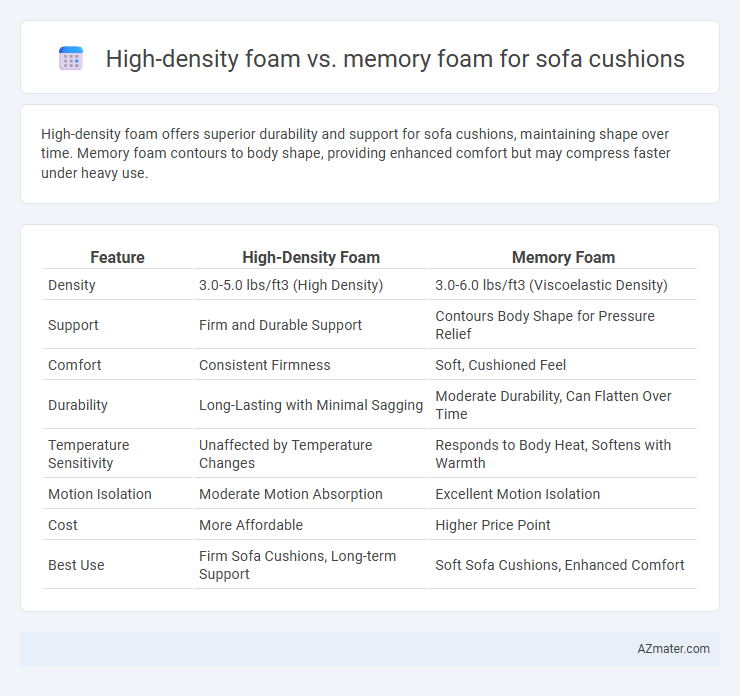High-density foam offers superior durability and support for sofa cushions, maintaining shape over time. Memory foam contours to body shape, providing enhanced comfort but may compress faster under heavy use.
Table of Comparison
| Feature | High-Density Foam | Memory Foam |
|---|---|---|
| Density | 3.0-5.0 lbs/ft3 (High Density) | 3.0-6.0 lbs/ft3 (Viscoelastic Density) |
| Support | Firm and Durable Support | Contours Body Shape for Pressure Relief |
| Comfort | Consistent Firmness | Soft, Cushioned Feel |
| Durability | Long-Lasting with Minimal Sagging | Moderate Durability, Can Flatten Over Time |
| Temperature Sensitivity | Unaffected by Temperature Changes | Responds to Body Heat, Softens with Warmth |
| Motion Isolation | Moderate Motion Absorption | Excellent Motion Isolation |
| Cost | More Affordable | Higher Price Point |
| Best Use | Firm Sofa Cushions, Long-term Support | Soft Sofa Cushions, Enhanced Comfort |
Understanding High-Density Foam
High-density foam for sofa cushions offers superior durability and support due to its higher weight per cubic foot, typically ranging from 1.8 to 2.8 pounds, which ensures long-lasting shape retention and resistance to sagging. Unlike memory foam, high-density foam provides a firmer feel and faster recovery time, making it ideal for individuals seeking consistent firmness and strong seat support. Its cellular structure allows for increased breathability, reducing heat retention and maintaining comfort during extended use.
What Is Memory Foam?
Memory foam is a viscoelastic polyurethane material known for its ability to conform to body shape, providing personalized comfort and pressure relief in sofa cushions. It responds to heat and weight, molding to the sitter's contours and returning to its original shape when weight is removed. Compared to high-density foam, memory foam offers superior motion isolation and a softer, more cushioned feel, making it ideal for those seeking enhanced support and comfort.
Key Differences Between High-Density and Memory Foam
High-density foam offers firm support and retains its shape longer, making it ideal for sofa cushions requiring durability and resilience. Memory foam provides superior contouring by responding to body heat and pressure, delivering personalized comfort and pressure relief. Key differences include the density of the foam, responsiveness to pressure, and longevity, with high-density foam excelling in structural support and memory foam emphasizing comfort and body adaptation.
Comfort and Support Comparison
High-density foam offers firm support with excellent resilience, maintaining shape and providing consistent comfort over extended use, ideal for those seeking a sturdy seating experience. Memory foam conforms to body contours, delivering superior pressure relief and personalized comfort, which reduces stress on pressure points and enhances relaxation. Choosing between high-density and memory foam largely depends on preferred firmness and support balance, with high-density foam excelling in durability and memory foam in adaptive comfort.
Durability and Longevity
High-density foam offers superior durability for sofa cushions due to its firm structure that resists sagging and maintains shape over time. Memory foam provides excellent comfort by contouring to the body but tends to soften and degrade faster with prolonged use. Choosing high-density foam enhances cushion longevity, making it ideal for daily use and extended wear.
Breathability and Temperature Regulation
High-density foam offers superior breathability due to its open-cell structure, allowing better airflow and preventing heat buildup in sofa cushions. Memory foam, while conforming closely to body shape for comfort, tends to retain heat because of its dense composition and viscoelastic properties. Choosing high-density foam enhances temperature regulation and maintains a cooler seating experience compared to traditional memory foam cushions.
Price and Value Considerations
High-density foam cushions typically offer excellent durability and support at a more affordable price compared to memory foam, making them a cost-effective choice for sofa cushions. Memory foam provides superior comfort and pressure relief by contouring to the body, but generally comes with a higher price point, impacting initial investment costs. When considering value, high-density foam balances longevity and budget-friendliness while memory foam delivers enhanced comfort and ergonomic benefits, justifying its premium cost for users prioritizing cushioning performance.
Maintenance and Care Tips
High-density foam sofa cushions require regular fluffing and rotation to maintain shape and compression resistance, while cleaning with mild detergent and avoiding prolonged sun exposure prevents foam degradation. Memory foam cushions benefit from gentle vacuuming to remove dust and occasional spot cleaning to maintain their contouring properties without water saturation, preserving their durability. Both foam types avoid chemical cleaners and excessive moisture to prevent breakdown and extend cushion lifespan.
Best Applications for Each Foam Type
High-density foam offers superior durability and support, making it ideal for sofa cushions subjected to frequent use and heavy weight, such as in family rooms or commercial settings. Memory foam excels in pressure relief and contouring comfort, best suited for lounge sofas where plush, body-conforming seating is prioritized. Choosing high-density foam is recommended for long-lasting firmness, while memory foam enhances relaxation with its adaptive softness.
Which Foam Is Right for Your Sofa Cushion?
High-density foam offers firm support and durability, making it ideal for sofa cushions that require shape retention and resistance to sagging over time. Memory foam contours to the body's shape, providing enhanced comfort and pressure relief but may compress faster under heavy use. Choosing between high-density foam and memory foam depends on your priority for durability versus cushioning softness and whether the sofa will endure frequent, heavy use or prioritize plush comfort.

Infographic: High-density foam vs Memory foam for Sofa cushion
 azmater.com
azmater.com